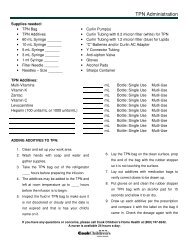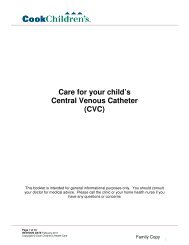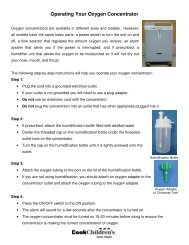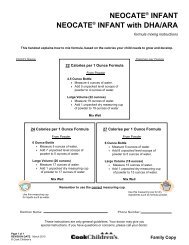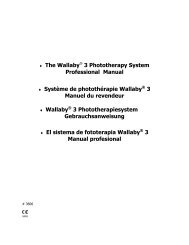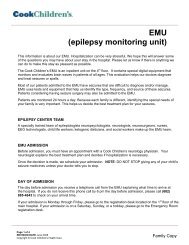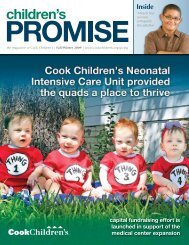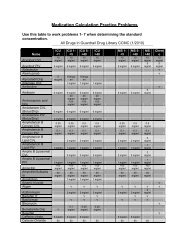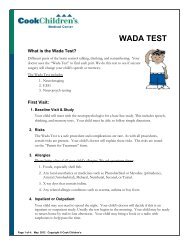02-HandoutsResonanceandVPD - Cook Children's
02-HandoutsResonanceandVPD - Cook Children's
02-HandoutsResonanceandVPD - Cook Children's
You also want an ePaper? Increase the reach of your titles
YUMPU automatically turns print PDFs into web optimized ePapers that Google loves.
Resonance Disorders and<br />
Velopharyngeal Dysfunction:<br />
Evaluation and Treatment<br />
Ann W. Kummer, PhD, CCC-SLP<br />
Cincinnati Children’s<br />
Hospital Medical Center<br />
• Employment:<br />
Financial Disclosures<br />
– Cincinnati Children’s Hospital Medical Center<br />
• Royalties<br />
– Author of the text called Cleft Palate and Craniofacial<br />
Anomalies: The Effects on Speech and Resonance,<br />
Delmar Cengage, 2008.<br />
– Developer of Oral and Nasal Listener (ONL), Super<br />
Duper Publications<br />
• Honoraria<br />
– Seminars at state conferences and other events<br />
1
Non-Financial Disclosure<br />
• Author of the SNAP test for nasometry<br />
• Serve on committees for the American Cleft<br />
Palate-Craniofacial Association<br />
• Serve on various advisory boards<br />
Seminar Outline<br />
2
Resonance Disorders and<br />
Velopharyngeal Dysfunction<br />
• Normal resonance<br />
• Resonance disorders<br />
• Normal velopharyngeal function<br />
• Velopharyngeal dysfunction (VPD)<br />
o Velopharyngeal insufficiency (VPI)<br />
o Velopharyngeal incompetence (VPI)<br />
o Velopharyngeal mislearning<br />
o Effects of CLP/VPI on speech and resonance<br />
Evaluation and Treatment<br />
• Evaluation<br />
o Perceptual evaluation<br />
o Intra-oral evaluation<br />
o Instrumental evaluation<br />
• Treatment of VPI<br />
o Surgical procedures<br />
o Prosthetic devices<br />
• Speech therapy<br />
• Referrals<br />
3
Normal Resonance<br />
What is resonance for speech?<br />
• Modification of the sound that is generated from<br />
the vocal cords thru selective enhancement of<br />
frequencies<br />
• Provides the quality of perceived sound during<br />
speech<br />
4
What determines resonance<br />
for speech?<br />
• Size and shape of the resonating cavities<br />
• pharyngeal cavity<br />
• oral cavity<br />
• nasal cavity<br />
• Function of the velopharyngeal valve<br />
Size and Shape of Cavities<br />
• Shorter/smaller cavities: enhance higher<br />
formants<br />
• Longer/larger cavities: enhance lower<br />
formants<br />
5
Size and Shape of Cavities<br />
Resonance is affected by the following:<br />
• Length and volume of pharynx<br />
• Size and shape of oral cavity<br />
• Configuration of nasal cavity<br />
Size and Shape of Cavities<br />
• Differences between<br />
– children and adults<br />
– men and women<br />
– tall people and short people<br />
• Makes voice quality unique to individual<br />
6
Resonance and Vowels<br />
• Vowels are “resonance sounds”<br />
• They are produced by changing the size and<br />
shape of the oral (resonating) cavity<br />
Resonance Disorders<br />
• Hypernasality<br />
• Hyponasality (denasality)<br />
• Cul de sac resonance<br />
• Mixed resonance<br />
7
Hypernasality<br />
• Too much sound resonating in the nasal<br />
cavity<br />
• Usually due to VPI or fistula<br />
• Most perceptible on vowels<br />
Hypernasality<br />
• Voiced oral consonants become<br />
nasalized (m/b, n/d, etc.)<br />
– Obligatory distortion<br />
• Other consonants may be substituted<br />
by nasals<br />
– Compensatory production<br />
8
Hyponasality<br />
• Not enough nasal resonance on nasal sounds<br />
(m, n, ng)<br />
• Due to nasal obstruction<br />
• Nasal phonemes sound similar to oral cognates<br />
(b/m, d/n, g/ng)<br />
• Also noticeable on vowels<br />
Cul de Sac Resonance<br />
• Sound resonates in a cavity (oral,<br />
pharyngeal or nasal), but cannot get out<br />
• Due to blockage in the vocal tract<br />
9
Cul de Sac Resonance<br />
• Voice sounds muffled and low in volume<br />
• Sound is absorbed (like a sponge) in the<br />
cavity<br />
Cul de Sac Resonance<br />
Types and Causes<br />
• Oral cul de sac resonance<br />
• Nasal cul de sac resonance<br />
• Pharyngeal cul de sac resonance<br />
10
Oral<br />
Cul de Sac Resonance<br />
• Sound is mostly in the oral cavity<br />
• Due to small oral cavity size or small mouth<br />
opening (microstomia)<br />
• Parents describe speech as “mumbling” (which<br />
is not opening the mouth very much)<br />
Nasal<br />
Cul de Sac Resonance<br />
• Sound is mostly in the nasal cavity<br />
• Due to VPI and nasal obstruction from:<br />
– a deviated septum<br />
– stenotic nares<br />
– maxillary retrusion<br />
• Common with cleft palate and craniofacial<br />
anomalies<br />
11
Pharyngeal<br />
Cul de Sac Resonance<br />
• Sound is mostly in the pharynx<br />
• Common in patients with very large tonsils<br />
Pharyngeal<br />
Cul de Sac Resonance<br />
• Has been called “potato-in-the-mouth” speech<br />
• Enlarged tonsils are the “potatoes”<br />
12
Pharyngeal<br />
Cul de Sac Resonance<br />
• Enlarged tonsils block sound transmission to<br />
oral cavity<br />
Mixed Resonance<br />
• Hypernasality and/or nasal emission on oral<br />
sounds and hyponasality on nasal sounds<br />
• Due to:<br />
– VPI and obstruction<br />
– Apraxia<br />
13
Normal Velopharyngeal Function<br />
Structures Active in VP Closure<br />
• Velum (Soft Palate)<br />
• Lateral Pharyngeal Walls (LPWs)<br />
• Posterior Pharyngeal Wall (PPW)<br />
14
Velum: Rest<br />
Velum (Soft Palate)<br />
• Moves in a superior and posterior direction<br />
• Has a type of “knee” action<br />
• Moves toward the posterior pharyngeal wall<br />
15
Velum: During Speech<br />
Physics and Flow<br />
• Water (and air) flow in a<br />
forward direction until<br />
something stops it<br />
• An obstructing object will<br />
redirect the flow<br />
16
Velopharyngeal Valve and Flow<br />
• Due to the physics of airflow, even a small<br />
opening will be symptomatic for speech.<br />
Lateral Pharyngeal Walls (LPWs)<br />
• Move medially to close against the velum or in<br />
some cases, behind the velum<br />
17
Posterior Pharyngeal Wall (PPW)<br />
• Has slight anterior movement toward the<br />
velum<br />
• In some speakers, there’s a bulge called a<br />
Passavant’s ridge (formed by muscle<br />
contraction)<br />
Passavant’s Ridge<br />
18
VP Valve during Speech<br />
• Velopharyngeal valve is closed for oral sounds<br />
– Most consonants (air pressure sounds)<br />
– All vowels (resonance sounds)<br />
• Velopharyngeal valve is open for nasal sounds (m,<br />
n, ng)<br />
Purpose of VP Valve<br />
• Directs transmission of sound<br />
energy and air flow in the oral and<br />
nasal cavities during speech<br />
19
Muscles of VP Closure<br />
• Levator veli palatini (velar “sling”)<br />
• Superior constrictor (pharyngeal ring)<br />
• Palatopharyngeus (post. faucial pillar)<br />
• Palatoglossus (ant. faucial pillar)<br />
• Musculus uvulae (bulge on nasal surface)<br />
Muscles of VP Closure<br />
20
Motor Nerves of VP Function<br />
• Glossopharyngeal (IX)<br />
• Vagus (X)<br />
• Accessory (XI)<br />
• Trigeminal (V)<br />
• Facial (VII)<br />
Sensory Nerves of Velum<br />
• Vagus (X)<br />
• Glossopharyngeal (IX)<br />
21
Normal VP Closure<br />
(Nasopharyngoscopy)<br />
Variations in VP Closure<br />
• Coronal Pattern<br />
– Due mostly to velar movement<br />
• Sagittal Pattern<br />
– Due mostly to LPW movement<br />
• Circular Pattern (with and without<br />
Passavant’s ridge)<br />
– All structures move and close like a purse string<br />
22
Patterns of Closure<br />
Variations in VP Closure<br />
• Non-Pneumatic:<br />
– gagging, vomiting, swallowing<br />
• Pneumatic:<br />
– Positive (+) pressure: blowing, whistling,<br />
speech<br />
– Negative (-) pressure: sucking, kissing<br />
23
Normal Velopharyngeal Function<br />
Learning (Articulation)<br />
Anatomy (Structure)<br />
Physiology (Movement)<br />
Velopharyngeal Dysfunction<br />
Articulation/Speech Learning<br />
(Velopharyngeal Mislearning)<br />
Anatomy<br />
(Velopharyngeal Insufficiency)<br />
Physiology<br />
(Velopharyngeal Incompetence)<br />
24
VPI: Velopharyngeal<br />
Insufficiency and Incompetence<br />
• Velopharyngeal insufficiency- abnormal<br />
structure<br />
• Velopharyngeal incompetence- abnormal<br />
neurophysiology<br />
Velopharyngeal Insufficiency<br />
25
VP Insufficiency<br />
• History of cleft palate<br />
• Submucous cleft palate (overt or occult)<br />
• Short velum or deep pharynx (cranial base<br />
anomalies)<br />
• Irregular adenoids<br />
• Enlarged tonsils<br />
History of Cleft Palate<br />
• Velum may be too short<br />
following repair<br />
• Velum may have a notch<br />
on posterior nasal surface<br />
26
Submucous Cleft Palate<br />
Nasal Surface<br />
Deep Pharynx<br />
• Can be due to cranial base or cervical spine<br />
anomalies (i.e., Klippel-Feil syndrome or<br />
craniosynostosis)<br />
27
Adenoids<br />
• Positioned in usual site of VP<br />
contact<br />
• Closure is velo-adenoidal in kids<br />
• Normal VP closure requires a<br />
tight seal<br />
• Adenoid protrusion or indentation<br />
can affect closure<br />
Irregular Adenoids<br />
28
Enlarged Tonsils<br />
• Can extend into pharynx, interfering with LPW<br />
and velar movement or preventing a tight VP<br />
seal<br />
Nasopharyngoscopy of Tonsil<br />
29
VP Insufficiency<br />
Following Surgery or Treatment<br />
• Adenoidectomy<br />
• Maxillary advancement<br />
• Treatment of nasopharyngeal tumors<br />
Adenoidectomy<br />
• Sudden increase in the nasopharyngeal<br />
dimension can cause VPI<br />
• Often temporary and resolves within 6 weeks<br />
• Permanent VPI is a risk, especially with history<br />
of cleft or submucous cleft<br />
30
VPI Post Adenoidectomy<br />
• Caused by a change in the structure<br />
• Speech therapy CANNOT change structure<br />
• Exercises don’t work because the problem is<br />
not the muscles<br />
• VPI post-adenoidectomy requires surgical<br />
intervention by a surgeon who specializes in<br />
clefts and VPI<br />
Le Fort I Maxillary Advancement<br />
31
Maxillary Advancement<br />
• Done surgically or through distraction<br />
• Corrects Class III malocclusion and midface<br />
retrusion<br />
• Improves aesthetics and articulation (obligatory<br />
distortions)<br />
• Often done for patients with history of cleft<br />
Pre Maxillary Advancement<br />
32
Post Maxillary Advancement<br />
Post Maxillary Advancement<br />
• Moving maxilla forward also moves velum<br />
forward<br />
• Velum may stretch and lengthen; LPW<br />
movement may increase<br />
• VPI is a risk, especially in patients with history of<br />
cleft or submucous cleft<br />
33
Treatment for Oral Cavity of<br />
Nasopharyngeal Tumors<br />
• Radiation therapy shrinks abnormal and<br />
surrounding normal tissue<br />
• Ablative surgery removes tissue<br />
• Both increase nasopharyngeal space, making<br />
closure more difficult<br />
Velopharyngeal Incompetence<br />
34
Causes of VP Incompetence<br />
• Cranial nerve damage<br />
• Central neurological dysfunction<br />
– Injury or neuromuscular disease<br />
Cranial Nerve Damage<br />
• Can cause velar paralysis or<br />
paresis<br />
• Often unilateral<br />
• Affected side of velum<br />
droops, causing a lateral gap<br />
• Uvula points to unaffected<br />
side<br />
• Common in hemifacial<br />
microsomia<br />
35
Central Neurological Dysfunction<br />
• Injury<br />
– Head trauma/traumatic brain injury<br />
– Cerebral palsy<br />
– CVA/stroke<br />
• Neuromuscular Disease<br />
– Myasthenia gravis, muscular dystrophy, etc.<br />
Central Neurological Dysfunction<br />
May cause:<br />
• Hypotonia<br />
• Dysarthria<br />
• Apraxia of speech<br />
• All of these can cause VP incompetence<br />
36
Hypotonia<br />
• Can cause poor or weak velar and pharyngeal<br />
movement<br />
• Pharyngeal hypotonia is common with<br />
velocardiofacial syndrome)<br />
Dysarthria<br />
• Affects all subsystems of speech:<br />
– Respiration<br />
– Phonation<br />
– Articulation<br />
– Velopharyngeal function<br />
37
Characteristics of Dysarthria<br />
• Slurred, imprecise articulation<br />
• Poor breath support<br />
• Decreased volume<br />
• Slow rate<br />
• Hypernasality- common<br />
Characteristics of Dysarthria<br />
• Poor movement of anterior structures (for<br />
articulation) and posterior structures for (VP<br />
closure)<br />
• Weakness increases with fatigue<br />
• Gradual onset of dysarthria with<br />
hypernasality is often the first symptom of a<br />
neuromuscular disease<br />
38
Apraxia of Speech<br />
• Motor speech disorder causing difficulty<br />
combining and sequencing motor movements<br />
• Affects coordination of subsystems of speech:<br />
– Articulation<br />
– Phonation (voiced/voiceless errors)<br />
– Velopharyngeal function (oral/nasal errors)<br />
Apraxia of Speech<br />
• Poor coordination, timing, and duration of<br />
VP closure<br />
• Velum goes up inappropriately for nasal<br />
sounds and down for oral sounds<br />
• Inconsistent hypernasality/hyponasality<br />
39
Velopharyngeal Mislearning<br />
Velopharyngeal Mislearning<br />
Causes:<br />
• Hearing Loss/Deafness<br />
• Secondary to VPI: Learned compensatory<br />
productions secondary to VPI<br />
• Secondary to Mislearning: Misarticulations that<br />
cause nasal emission unrelated to a VPI<br />
40
Hearing Loss/Deafness<br />
• Need auditory feedback because<br />
there is no tactile-kinesthetic<br />
feedback of VP movement<br />
• Results in a mixture of hyper- and<br />
hyponasality<br />
“Hypernasality” due to Misarticulations<br />
• Nasalization of vowels<br />
– Back of tongue too high on vowels<br />
– Can be phoneme-specific on the high vowel /i/<br />
41
“Hypernasality” due to Misarticulations<br />
• Substitution of nasal consonants for oral<br />
consonants (i.e., ng/l, ng/r)<br />
Nasal Emission due to Misarticulation<br />
• Due to pharyngeal or posterior nasal fricatives<br />
• Causes phoneme-specific nasal air emission<br />
(PSNAE)<br />
• Usually occurs on sibilants, particularly s/z<br />
• Child is usually stimulable<br />
42
Recommendations for<br />
VP Mislearning<br />
• Speech therapy because this is a speech<br />
sound (articulation) disorder<br />
• Surgery is NOT indicated!!!<br />
• Differential diagnosis is very important!<br />
Effects of Cleft Palate and VPI<br />
on Speech and Resonance<br />
• Abnormal resonance (sound)<br />
• Nasal air emission (airflow)<br />
• Dysphonia (sound)<br />
43
Abnormal Resonance due to CLP<br />
• Hypernasality due to VPI or fistula<br />
• Hyponasality or cul de sac resonance due to<br />
blockage<br />
Nasal Air Emission<br />
• Occurs with or without hypernasality<br />
• Air leaks through the valve<br />
• Occurs on high pressure consonants,<br />
particularly voiceless consonants<br />
44
Types of Nasal Emission<br />
• Large opening<br />
• Small opening<br />
– Nasal Rustle (Turbulence)<br />
Nasal Emission with Large Opening<br />
• No impedance to airflow<br />
• Soft, low intensity sound<br />
• Affects articulation and utterance<br />
length<br />
45
Nasal Emission<br />
with Large Opening<br />
Can also cause:<br />
• Weak or omitted consonants<br />
• Short utterance length<br />
• Nasal grimace<br />
• Compensatory articulation productions<br />
Weak or Omitted Consonants<br />
• Greater the nasal air emission, the weaker<br />
the consonants will be due to loss of oral air<br />
pressure<br />
• Affects pressure-sensitive consonants<br />
46
Short Utterance Length<br />
• Leak of air pressure causes need to increase<br />
respiratory effort and take more frequent breaths<br />
• Utterance length becomes shortened<br />
Nasal Grimace<br />
• Contraction seen at side of<br />
nose or at nasal bridge<br />
• Overflow muscle reaction in<br />
attempt to close VP valve<br />
47
Compensatory Productions<br />
for Palatal Fistula<br />
• Production is behind the fistula, before air<br />
can escape through it.<br />
Plosives (Stops) Fricatives<br />
• Velar plosive (backing of • Velar fricative<br />
anterior sounds)<br />
Velar Fricative<br />
48
Compensatory Productions<br />
for VPI<br />
Plosives (Stops)<br />
• Pharyngeal plosives<br />
• Glottal stops<br />
Fricatives<br />
• Pharyngeal fricatives<br />
• Posterior nasal fricatives<br />
• Glottal fricative (/h/)<br />
• Nasal sniff<br />
Pharyngeal Plosive<br />
49
Glottal Stop<br />
Can be Co-Articulated<br />
Pharyngeal Fricative<br />
50
Posterior Nasal Fricative<br />
Posterior Nasal Fricative<br />
• Back of tongue articulates against velum<br />
• Air pressure forced into pharynx<br />
• VP valve opens for release of air pressure<br />
• Causes phoneme-specific nasal air emission<br />
(PSNAE)<br />
51
Glottal Fricative (/h/)<br />
• Substituted for oral fricatives<br />
Nasal Sniff<br />
• Occurs as a substitution for sibilants,<br />
particularly /s/<br />
• Usually occurs in the final word position<br />
52
Compensatory Productions<br />
for VPI<br />
• Manner of production is maintained<br />
• Placement is in pharynx to take advantage of<br />
air flow<br />
• VP valve will be opened during production, so<br />
there will be associated nasal emission<br />
Compensatory Productions<br />
for VPI<br />
• Nasal emission is due to production, so persists,<br />
even after surgery for VPI<br />
• Speech therapy is needed postoperatively to<br />
correct placement (which will eliminate nasal<br />
emission)<br />
53
Nasal Emission<br />
with Small Opening<br />
• Characterized by an inconsistent nasal<br />
rustle (nasal turbulence)<br />
• Due to bubbling of secretions as air<br />
forced through the small opening<br />
• Distortion is loud and distracting<br />
• Has no effect on strength of consonants<br />
or utterance length<br />
• Usually does not occur with hypernasality<br />
Nasal Emission<br />
with Small Opening<br />
• Patient can usually close with effort<br />
• Opening increases with motoric demands and<br />
fatigue<br />
• Can correct “in therapy”- but child will not be<br />
able to maintain it<br />
• Therefore, even a small structural gap will<br />
require surgical correction<br />
54
Dysphonia<br />
• Hoarseness<br />
• Breathiness<br />
• Abnormal pitch<br />
Dysphonia<br />
• Vocal cord nodules due to strain in<br />
the vocal tract with VPI<br />
• Laryngeal anomalies with<br />
craniofacial syndromes<br />
• Compensatory strategy<br />
– Breathiness and low volume<br />
mask hypernasality and nasal<br />
emission<br />
55
Prediction of Gap Size<br />
based on perceptual features<br />
→Hypernasality, inaudible nasal emission, weak<br />
consonants, short utterance length,<br />
compensatory productions<br />
→Hypernasality, audible nasal emission, weak<br />
consonants, may have compensatory<br />
productions<br />
→Possibly mild hypernasality and audible nasal<br />
emission<br />
→Normal resonance, but inconsistent nasal rustle<br />
(turbulence)<br />
56




